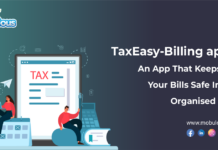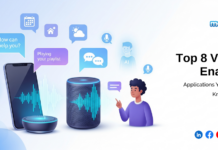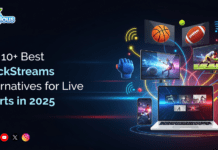What is a Voice-Enabled Application?
A voice-enabled application is a smart piece of software that lets you control it just by speaking. No more typing, tapping, or swiping. These apps use speech recognition technology. They turn your spoken words into text, which is then used to carry out a task.
Think of it like talking to a friend. But in this case, the “friend” is a digital assistant. These apps can help you do many things. From setting reminders to answering questions, they simplify everyday life. And the best part? You don’t even have to lift a finger.
If you’re thinking of building your own voice assistant, consider working with a chatbot app development company.
List of Top 8 Voice-Enabled Applications in 2025
- Google Assistant
- Amazon Alexa
- Siri
- DataBot Personal Assistant AI
- Voice Search Assistant
- Cortana
- Braina
- Jarvis Artificial Intelligence
Top 8 Voice-Enabled Applications: Features, Pros, Cons & Best Use Case
1. Google Assistant
Google Assistant is one of the smartest voice-enabled applications in 2025. It works across phones, smart devices, and even cars. You can ask it questions, control smart home gadgets, or set reminders. It understands natural speech well and gives personalized answers.
Features
- It connects with apps like Gmail, Calendar, YouTube, and Maps.
- You can speak in over 40 languages. It understands and responds.
- It can translate your voice in real time. That’s great for travel.
Pros
- Fast response time
- Smart home integration
- Multilingual support
Cons
- Limited offline usage
- Requires internet access
- Privacy concerns
Best Use Case: Use it for daily tasks like setting alarms, checking traffic, or sending a quick text. It’s your go-to digital helper when multitasking.
Read more: What is Google MUVERA? Everything You Need to Know in 2025
2. Amazon Alexa
Amazon Alexa is a popular voice-enabled application, especially for smart homes. It powers Echo devices and connects with many smart gadgets. Alexa can play music, control lights, answer questions, and even place Amazon orders.
Features
- It connects to smart lights, thermostats, and even your coffee maker.
- You can shop using your voice. Say, “Order paper towels,” and it does.
- Alexa Skills let you add custom features easily.
Pros
- Versatile usage scope
- Strong ecosystem integration
- Custom skill options
Cons
- Weak natural conversation
- Device-specific limitations
- Inconsistent app performance
Best Use Case: Perfect for turning your home into a smart space. Use it to dim the lights, play music, and restock your pantry, all hands-free.
3. Siri
Siri is Apple’s built-in voice-enabled application. It runs on iPhones, iPads, Macs, and Apple Watches. Siri understands voice commands well and works with most Apple services. It’s fast, private, and easy to use.
Features
- You can use Siri to set reminders, check the weather, or send texts.
- It works offline for simple tasks like timers or calculations.
- It now supports more automation via Shortcuts.
Pros
- Great for Apple users
- Secure voice processing
- User-friendly interface
Cons
- Apple-only platform
- Limited third-party access
- Sometimes misinterprets commands
Best Use Case: Ideal for Apple users who want to automate tasks, control apps, and ask quick questions using their voice.
4. DataBot Personal Assistant AI
DataBot is a fun and interactive voice-enabled application. It acts like a personal robot that talks, remembers, and learns. It’s customizable and great for casual users. You can ask it questions, tell it jokes, or even have it help with studies.
Features
- It gives you news, jokes, and weather reports.
- It summarizes Wikipedia articles or documents.
- It keeps voice memos and reminders.
Pros:
- Cross-platform flexibility
- Easy task automation
- Informational summaries
Cons:
- Lacks personality depth
- Limited smart home control
- Ads in the free version
Best Use Case: Great for students or solo professionals who need a voice assistant for studying, scheduling, or quick answers.
5. Voice Search Assistant
This is one of the simplest voice-enabled applications. It focuses only on voice search. Open it, speak your question, and it gives answers right away. It’s not a full assistant, but it’s very fast and easy to use.
Features
- It lets you search Google, Bing, and more with voice.
- Works across multiple browsers.
- Designed for quick access and speed.
Pros:
- Fast voice responses
- Clean user interface
- Low battery usage
Cons:
- No smart features
- Basic voice interaction
- Limited integration
Best Use Case: Best when you’re on the go. Use it while driving or cooking to search without touching your phone.
6. Cortana
Cortana is Microsoft’s voice-enabled application. While not widely used anymore, it still helps in some office and business settings. It’s part of Windows and Microsoft 365 services.
Features
- It manages calendars and sets reminders.
- It reads emails out loud.
- Works well with Microsoft Office tools.
Pros:
- Microsoft integration
- Great for reminders
- Minimalist setup
Cons:
- Retired from consumers
- No app updates
- Poor third-party support
Best Use Case: Useful for professionals in Microsoft’s ecosystem who want simple voice scheduling and task management.
7. Braina
Braina is a smart voice-enabled application for PC users. It’s like a virtual assistant for Windows computers. It helps with typing, programming commands, and even web searches. It’s especially useful for professionals and students.
Features
- Supports over 100 languages.
- Dictates into any software.
- Lets you give voice commands to your computer.
Pros:
- High customization
- Business-friendly tools
- Strong dictation support
Cons:
- PC-only availability
- Steep learning curve
- Paid version needed
Best Use Case: Excellent for professionals who want to write, code, or manage work faster using only voice.
8. Jarvis Artificial Intelligence
Jarvis is a creative and fun voice-enabled application. It’s inspired by Iron Man’s assistant. Jarvis adds personality to everyday tasks. It may not be super powerful, but it’s charming and helpful.
Features
- Responds in a conversational, friendly tone.
- Can be customized to talk like “Tony Stark’s Jarvis.”
- Handles simple tasks like timers, searches, or notes.
Pros:
- Engaging personality
- Customizable scripts
- Fun to use
Cons:
- Limited real AI
- Basic command depth
- Mostly novelty-based
Best Use Case: Perfect for users who want a fun, engaging assistant that offers basic help while making tech feel futuristic.
Why Are Voice-Enabled Applications Famous in 2025?
In 2025, voice-enabled apps are everywhere. Why? Because they make life easier. People want speed, comfort, and efficiency, and these apps offer all of that.
Technology has improved a lot. AI and natural language processing are now more accurate. Smart devices are more common, too. From phones and TVs to cars and homes, everything can now “listen” to you.
We live in a fast world where multitasking is the norm. Voice apps help you get more done while you’re on the move. That’s why they’ve become such an essential part of modern life.
Looking to build the next big thing in communication? Explore what a top video chat app development company can do to bring your voice and video ideas to life.
Conclusion
Voice-enabled apps have become a must-have in 2025. They save time, reduce effort, and bring convenience to our fingertips, or rather, our voices. From serious work tasks to fun sci-fi vibes, there’s a voice assistant for everyone. The future isn’t coming, but it’s already speaking loud and clear.
FAQs – Top Voice-Enabled Applications
Q1. What are the applications of voice recognition?
Voice recognition is now used in homes, offices, hospitals, and even cars. It helps with tasks like searching online, typing documents, answering calls, and more. It also offers a big help to users with physical limitations.
Q2. What is voice-enabled technology?
Voice-enabled technology lets people interact with machines using spoken words. It makes using phones, TVs, and apps easier by skipping screens and buttons. It’s all about talking and getting stuff done fast.
Q3. What is the meaning of a voice application?
A voice application is a tool that listens to what you say and responds. It turns speech into action. Whether it’s setting a reminder or finding a song, it works just like a human assistant, but only digitally.
Q4. Is voice recognition an AI?
Yes, voice recognition uses artificial intelligence. It listens, learns, and understands how people speak. This helps it improve with time, making voice apps smarter the more you use them.
Q5. Is there a voice-activated AI app?
Yes, many apps are powered by voice-activated AI. Popular ones include Google Assistant, Alexa, and Siri. You can wake them with a phrase and start asking questions right away. It’s like having a personal helper in your pocket.
































